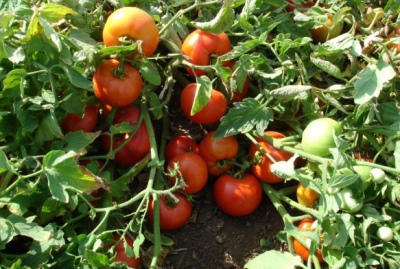
- Authors: Nunhems B.V.
- Year of approval: 2005
- Name synonyms: Shady Lady
- Category: hybrid
- Growth type: determinant
- Appointment: fresh consumption
- Ripening period: early
- Ripening time, days: 98-108
- Growing conditions: for open ground, for film greenhouses, for greenhouses
- Transportability: high
Hybrid fruit crops from Holland have become widespread due to unpretentious care, excellent yield and marketability. These varieties include the Shedi Lady tomato. It is perfect for cultivation in many regions of Russia.
Description of the variety
The fruits of the hybrid are usually eaten fresh in order to fully enjoy their taste. Low-growing bushes with a determinant type of growth reach no more than one meter in height. Plants are planted in open areas or in various types of greenhouses. Plants are compact, neat and do not take up much space on the site. Their leaves are bright green and large. The foliage resembles that of a potato in shape. This feature indicates the high resistance of the culture to fungal infections.
The main qualities of the fruit
Unripe tomatoes can be green or light green. As they mature, their color changes to a standard red. Fruit weight reaches 200 grams. They are large in size and round in shape. A large number of seed chambers (5-6 pieces) are hidden inside. The pulp is firm and juicy, covered with a glossy skin. The surface is covered with fine ribs in the area of the stalk attachment.
The dense skin will keep vegetables from cracking and help keep them attractive during transport, handling or harvesting.
The table variety is suitable for the following culinary intentions:
- salting in barrels;
- drying;
- heat treatment when preparing hot dishes;
- ingredients for a salad or snack;
- preparation of aromatic juice;
- preservation as a whole.
Fully ripe tomatoes have an attractive appearance, both whole and cut. Therefore, they are often decorated with vegetable cuts and various dishes.
Taste characteristics
Ladies speak positively about the expressive taste of the Shedi tomato. When properly cared for, the vegetables will grow juicy and sweet.
Ripening and fruiting
The hybrid is an early fruit crop. It takes only 98 to 108 days to form and ripen a crop. As soon as the tomatoes reach brown ripeness, they begin to be removed. This period starts in July and lasts until September.
Yield
The Dutch variety pleases with a stable and rich harvest. Up to 7.5 kilograms of vegetables are harvested from a square meter of land.
The timing of planting seedlings and planting in the ground
The above variety is grown using seedlings. Before each new sowing, you need to re-collect or buy sowing material, since hybrid seeds will not germinate from the second generation. Sowing begins with the onset of the third decade of March. In some regions, work begins in early April. After about 2 months, the seedlings are transplanted to a permanent cultivation site. This period will be enough for the seed to form a full-fledged sprout with leaves and a developed root system.
The seeding pattern is as follows.
- The container for planting seed is prepared in advance. If the containers have already been used, they must be cleaned and disinfected. The depth should be more than 7 centimeters. Used containers are treated with a chlorine solution. There must be drain holes at the bottom.
- The second step is to prepare the soil. On sale you can find ready-made compositions designed specifically for tomatoes and other fruit crops. To prepare the substrate yourself, you need to mix sand, peat, humus and sod. The prepared soil should be nutritious and light.
- The bottom is covered with expanded clay or charcoal 2 centimeters thick. After spreading 5 centimeters of soil mixture.
- The grains are deepened by about 2 centimeters.
- Moisten the soil with warm water.
- The containers are covered with foil or glass.
- As soon as the first shoots hatch, the shelters are removed.
- A suitable temperature range is from 22 to 24 degrees Celsius.
- Seedlings are dived into separate cups or pots after the third true leaf.
Seedlings need regular watering and ventilation so that there is no stagnation of moisture.

Growing tomato seedlings is an extremely important process, because it largely depends on whether the gardener can harvest at all. All aspects must be taken into account, from seedbed preparation to planting in the ground.
Landing scheme
No more than 3-4 bushes are grown on one square meter of the bed. The landing pattern is 50x50 centimeters.

Growing and caring
In order for the tomatoes to grow as large and juicy as possible, you need to shape the bushes. The best option is two-stem cultivation. 10 days after the transfer, the lower leaves and stepsons begin to be removed from the tomatoes. If you leave extra lateral shoots, the yield of the variety will decrease.
The vegetable plantation is irrigated with warm and settled water every 3-6 days. After watering, the topsoil is loosened, deepening by 4-5 centimeters. Loosening deeper can damage the roots. When weeds appear on the site, you must immediately pull them out by the roots.
Any fruit crop needs a sufficient amount of nutrients. Their lack worsens the taste of the fruit and negatively affects the condition of the bushes. Tomatoes are fed with NPK complexes once every 2 weeks. The preparations are applied after watering.




A plant needs different micronutrients at each stage of growth. All fertilizers can be divided into two groups: mineral and organic.Folk remedies are often used: iodine, yeast, bird droppings, eggshells.
It is important to observe the rate and period of feeding. This also applies to folk remedies and organic fertilizers.



























































































